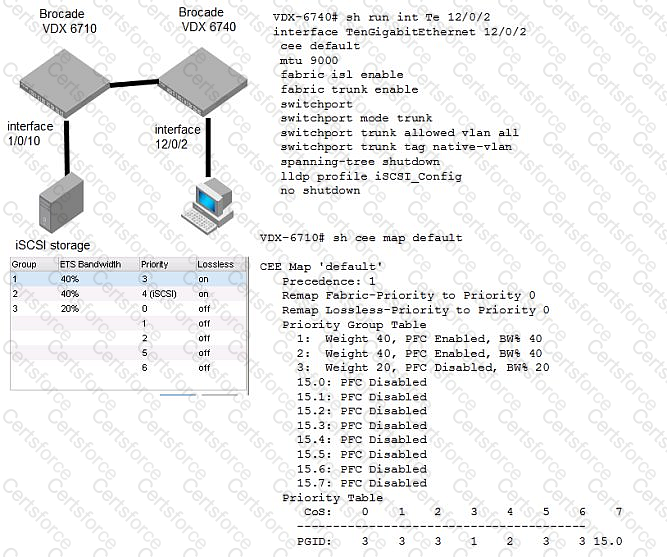You are introducing a Brocade VCS Fabric to your network and would like to implement Fibre Channel using the same switch.
Which switch would you use?
You are required to deploy servers with a single adapter that are attached to your Brocade VCS Fabric to communicate with FC SAN attached storage.
What is required?
You have a server with four Ethernet interfaces and want to aggregate your links into a single bundle across two Brocade VDX switches.
Which two statements are true? (Choose two.)
You are troubleshooting an FCoE login problem in your environment. The port shown in the exhibit has not been able to log into the fabric. The default FCoE fabric map in your environment has not been changed.
Interface TenGigabitEthernet 3/0/4
Mode PFC
DCBX enabled for PFC negotiation
TX 0 frames
TX TX RX RX Output Paused
CoS Admin Oper Admin Oper 512 BitTimes
---------------------------------------
0 Off Off Off Off 0
1 Off Off Off Off 0
2 Off Off Off Off 0
3 On Off On Off 0
4 Off Off Off Off 0
5 Off Off Off Off 0
6 Off Off Off Off 0
7 Off Off Off Off 0
sw0(conf-if-te-3/0/1-24)# do show lldp neighbors interface ten 3/0/4 detail
Neighbors for Interface Te 3/0/4
---
DCBX TLVs
===========
Version : CEE
DCBX Ctrl OperVersion: 0 MaxVersion: 0 SeqNo: 4 AckNo: 6
DCBX ETS OperVersion: 0 MaxVersion: 0 Enabled: 1 Willing: 0 Error: 1
Enhanced Transmission Selection (ETS)
Priority-Group ID Map:
Priority : 0 1 2 3 4 5 6 7
Group ID : 0 0 0 0 1 0 0 0
Group ID Bandwidth Map:
Group ID : 0 1 2 3 4 5 6 7
Percentage: 50 50 0 0 0 0 0 0
Number of Traffic Classes supported: 2
DCBX PFC OperVersion: 0 MaxVersion: 0 Enabled: 0 Willing: 0 Error: 1
Priority-based Flow Control (PFC)
Enabled Priorities: 3
Number of Traffic Class PFC supported: 8
FCoE App OperVersion: 0 MaxVersion: 0 Enabled: 1 Willing: 0 Error: 0
FCoE Application Protocol
User Priorities: 4
What are two causes of the problem? (Choose two.)
Exhibit:
switch# show ip route
Destination Gateway Port Cost Type Uptime
1 0.0.0.0/0 10.24.64.1 mgmt 1 1/1 S 8m24s
2 1.1.1.0/24 10.1.1.10 Ve 10 1/1 S+ 3m11s
3 1.1.2.0/24 DIRECT Ve 12 0/0 D 3m11s
4 10.24.64.0/20 DIRECT mgmt 1 0/0 D 8m28s
Exhibit:
Referring to the exhibit, which statement is true?
You have a Brocade VCS Fabric and one Brocade VDX has the multicast root manually assigned with the highest priority. You are going to remove that VDX from the fabric.
Which switch will become the multicast root if no other device has the priority set?
Referring to the exhibit, which statement is correct?
Exhibit:
VDX8770_3-131# sh port-c 123
LACP Aggregator: Po 123
Aggregator type: Standard
Ignore-split is enabled
Admin Key: 0123 - Oper Key 0123
Partner System ID - 0x0000,00-00-00-00-00-00
Partner Oper Key 0000
Member ports on rbridge-id 131:
Link: Te 131/2/16 (0x8318880086) sync: 0
VDX8770_3-131# show running-config interface Port-channel 123
interface Port-channel 123
vlag ignore-split
switchport
switchport mode trunk
switchport trunk allowed vlan add 10,30
switchport trunk tag native-vlan
spanning-tree shutdown
no shutdown
Exhibit:
Your Brocade VCS Fabric design will include vLAG connectivity to devices in your data center.
Which three statements are true? (Choose three.)
-- Exhibit –

-- Exhibit --
Click the exhibit button.
You notice that iSCSI traffic is slow on the iSCSI storage device. The
Brocade VCS Fabric is in logical-chassis mode.
Which two actions would increase performance? (Choose two.)
Your current VCS fabric comprised of Brocade VDX 8770s is running NOS 4.0.0b in logical chassis mode. You would like to upgrade the firmware with no impact to L2 traffic.
Which two procedures would accomplish this task? (Choose two.)